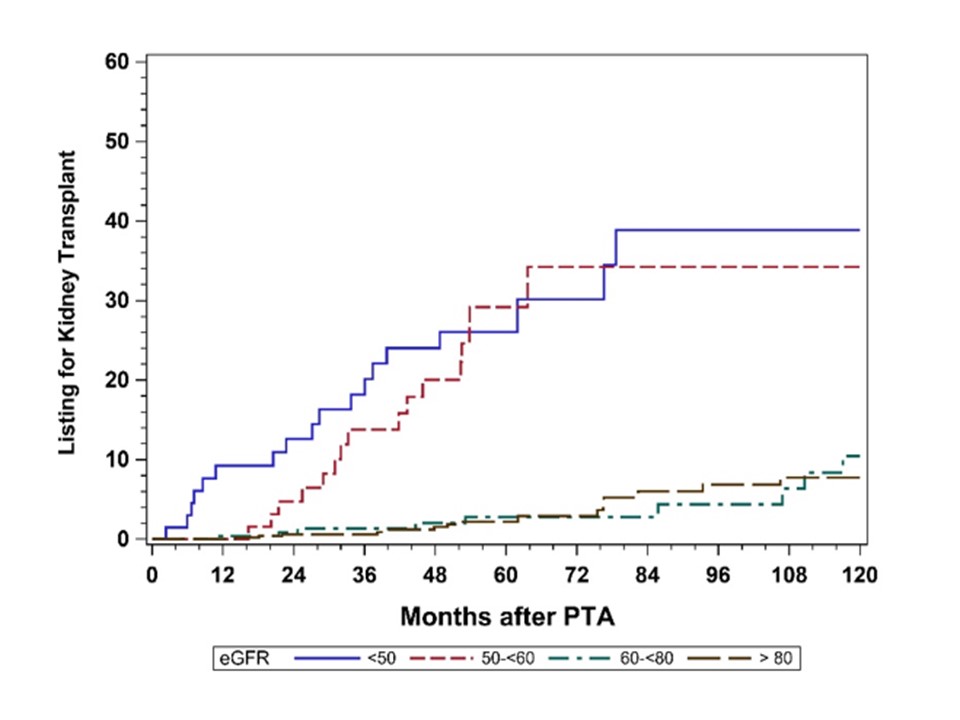Risk Factors for Failing Native Kidney Function after Successful PTA
SUNY Downstate Medical Center, Brooklyn, NY
Meeting: 2020 American Transplant Congress
Abstract number: B-308
Keywords: Graft function, Kidney, Pancreas transplantation
Session Information
Session Name: Poster Session B: Pancreas and Islet: All Topics
Session Type: Poster Session
Date: Saturday, May 30, 2020
Session Time: 3:15pm-4:00pm
 Presentation Time: 3:30pm-4:00pm
Presentation Time: 3:30pm-4:00pm
Location: Virtual
*Purpose: Patients with labile diabetes and good kidney function are often advised to wait until kidney function deteriorates and then undergo a SPK rather than a PTA. However, the combination of hypoglycemia and diabetic nephropathy is one of the highest risk factors for patient death. Therefore, mortality on the waiting list is much lower for a PTA vs. a SPK candidate. Our study identifies risk factors which impact native kidney function after a successful PTA.
*Methods: All 1,057 primary adult PTAs performed between 2004 and 20014 were included in this study. Patients who were initially listed for a SPK due to diminished kidney function but underwent a PTA instead or technically unsuccessful transplants were excluded. The time of kidney failure was defined as being wait-listed for a kidney transplant. The eGFR at time of PTA was computed to assess native kidney function at time of PTA. Comprehensive uni- and multivariate analyses were performed to assess possible risk factors for native kidney function.
*Results: The 1-year pancreas graft function of technically successful PTA improved from 88.5% in 2004-08, to 90.8% in 2009-13, and 89.5% in 2014-18 (p=0.20). Five-year PTA graft function was over 66%. The median eGFR at time of PTA increased significantly from 83mL/min/1.73m2 in 2004-08 to 90 mL/min/1.73m2 in 20014-18 (p=0.007). During the study time period no changes in native kidney failure rates were detected (p=0.92). Figure 1 shows the time to listing for a kidney transplant by initial eGFR. Figure 1 also demonstrates that the logistic regression identified the optimal cut point for sufficient native kidney function as >60mL/min/1.73m2. Our multivariate analysis of potential donor, recipient, and transplant risk factors only identified a failed pancreas graft as an additional risk factor for a subsequent kidney transplant. Treatment for acute rejection alone did not increase the relative risk for listing for listing.
*Conclusions: A PTA can preserve native kidney function for a long time using current immunosuppressive regimens if the eGFR is greater 60mL/min/1.73m2 at the time of transplant. Good pancreas graft function is necessary for good native kidney function.
To cite this abstract in AMA style:
Gruessner A, Saggi S, Renz J, Gruessner R. Risk Factors for Failing Native Kidney Function after Successful PTA [abstract]. Am J Transplant. 2020; 20 (suppl 3). https://atcmeetingabstracts.com/abstract/risk-factors-for-failing-native-kidney-function-after-successful-pta/. Accessed December 17, 2025.« Back to 2020 American Transplant Congress

